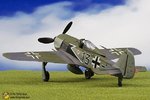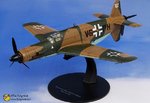Aramis
Airman
Hello, friends... I have recently bought these two 1:72 diecasts for my collection: a Do 335 and a Fw190 (JG 26, Josef Priller). I'd like to improve their accuracy by painting the propellers and spinner which I believe were not originally black. I don't have good profiles of those airplanes but I wonder if their propellers were really painted in dark green (RLM 70). Also, does anyone know about the spinner of those aircrafts... were the spinners also RLM 70 in both airplanes? Thanks!






